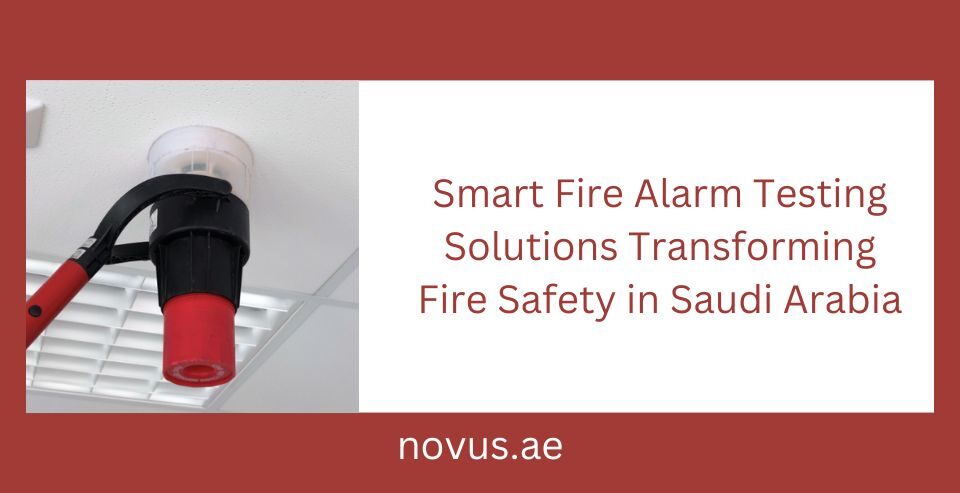
Smart Fire Alarm Testing Solutions Transforming Fire Safety in Saudi Arabia
October 8, 2025How Technology Is Changing the Future of Heat Detector Testers
November 7, 2025When it comes to safeguarding your property and the people inside it, fire alarm testing in Saudi Arabia is not optional—it’s essential. Whether you manage a commercial complex, industrial site or residential high-rise, regular smoke alarm testing in KSA and comprehensive fire alarm system testing ensure your fire safety systems respond when needed most.
Many building owners and facility managers also overlook the importance of fire alarm system inspection and the role of professional fire alarm testing services in maintaining compliance with local regulations and industry standards.
This checklist is designed to guide you step-by-step, helping you understand what to look for, when to schedule it and how to document it—all to reduce risk, meet regulatory requirements and enhance occupant safety.
Why this checklist matters
In Saudi Arabia, the environmental conditions—such as high temperatures, dust and sand—place extra stress on alarm systems, making consistent testing and inspection vital. Moreover, the local regulations and permit requirements mean that failing to provide documented proof of system reliability can lead to significant liability and downtime.
For building owners and facility managers, implementing a structured Fire Alarm Testing Checklist not only supports compliance but also enhances overall protection of assets and lives.
1. Establishing your testing schedule
- Define the frequency of tasks: monthly, quarterly, semi-annual, or annual.
- Include smoke alarm testing in KSA for all smoke detectors and fire zones.
- Schedule full fire alarm system testing at least annually (or as required by local code).
- Ensure your partner for this work is a qualified provider of fire alarm testing services.
- Maintain a logbook or digital record of each test and inspection.
2. Visual inspection checklist (monthly/quarterly)
- Ensure all smoke detectors, manual call points, sounders and panels are free from dust, debris or visible damage.
- Confirm battery backup units and power supplies are connected and showing no faults.
- Check that wiring, conduits and junction boxes are intact and properly labeled. documentation, and
- Verify that the fire alarm panels show no active fault, supervisory, or trouble signals.
- Inspect each exit-route sounder, beacon or alarm device for visible obstruction to fire
- As part of fire alarm system inspection, inspect the condition of fire alarm cabinets,labeling.nd zone labelling.
3. Functional testing checklist (quarterly/semi-annual)
- Activate a sample of smoke detectors (either by test smoke or simulated stimulus the control and confirm the control panel receives appropriate signals—this is core to your fire alarm system testing.
- Operate manual call points (break-glass or pull stations) to ensure they trigger the alarm system.
- Test sounders, strobes, alarms and voice-evacuation devices for audible/visible output.
- Confirm that fire alarm panels register the activations and display correct zone information.
- Test communication links to any monitoring station or central control (if applicable).
- Verify that any fire alarm annunciator boards or remote indicators function correctly.
4. Full system inspection & annual test
- A full system test should be done at least once every 12 months (or as required under local regulations) and should include:
- All detectors, modules, panels and outputs.
- Battery capacity test, power supply failures and UPS/fault conditions.
- Ensure the entire system meets functional integrity as a part of your fire alarm testing services.
- Review system logs, alarm history, previous test results and fault logs.
- Ensure your selected service provider is capable of providing a full fire alarm system inspection report, including pass/fail and recommended corrective actions.
- Document all findings and maintain Saudi regulation requirements.
- Ensure you receive a certificate of completion or compliance when the job is done.
5. Documentation & compliance
- The maintenance includes the date and the following: date, tester name/company, devices tested, reactions, corrective actions, and retest date.
- Store inspection certificates, service reports, and any regulatory compliance documents together.
- Building owners should retain records for at least the period specified —theyl authority – they may be asked to present them to Saudi Civil Defense or other regulatory bodies.
- When you enlist external fire alarm testing services, check that they issue clear documentation with device-by-device results and any failures flagged.
- Use this documentation to plan preventive maintenance, budget for replacements, and highlight trends (for example, detectors with frequent faults).
6. Common issues found during testing & how to prevent them
- Dust and environmental ingress causing false alarms or detector failure (especially relevant in KSA’s climate).
- Dead or weak backup batteries causing system fault during mains failure.
- labeling,ct zone call points,roken call-points, or missing signage.
- Stale or older fire alarm panels missing software updates, causing lack of compliance with modern standards.
- Lack of documentation or inconsistent testing schedules leading to regulatory risk.
Prevention tips:
- Set a maintenance routine including cleaning detectors and panels.
- Replace batteries at manufacturer-recommended intervals and after any fault.
- Use approved fire alarm testing services with experience in Saudi Arabia so that they understand the local code and environment.
- Train facility staff on daily and weekly checks and raise issues promptly.
- Review previous inspection reports and close out outstanding actions.
7. Leveraging technology & service providers
- Many modern fire-alarm systems allow remote fault alerting—this adds value to the program. pection program.
- Select a vendor offering full life-cycle service: fire alarm system inspection, testing, maintenance and certification.
- Use cloud-based logging or mobile apps to track your checklist execution, actions and retest follow-ups—this aligns with smart facility management.
- Ensure that your service provider adheres to international stan72),ds (e.g., NFPA 72) as these often underpin local regulation.
- Consider a service contract that covers regular fire alarm testing, periodic full inspections, and troubleshooting support.
Final thoughts
As a building owner or facility manager in Saudi Arabia, adopting a structured Fire Alarm Testing Checklist is both a regulatory necessity and a best practice. Regular checks—from simple visual inspections to full system tests—help you stay ahead of faults, ensure occupant safety and protect your assets.
By engaging professional fire alarm testing services, aligning with local regulations, documenting each step and leveraging digital tools, you set your facility up for reliable performance and regulatory compliance. Make the checklist part of your safety routine today—and keep your system ready for the moment it matters most.
FAQs
Q1: What is the difference between fire alarm system testing and fire alarm system inspection?
A1: Fire alarm system testing refers to the functional checks (activating devices, verifying alarms, checking panels). Fire alarm system inspection is broader—it includes visual checks, review of documentation, and assessment of system design, wiring, labeling, and records. Both are important and often overlap in practice.
Q2: How often should smoke alarm testing in KSA be conducted?
A2: While specific frequencies depend on building type and local requirements, a best practice is monthly visual checks, quarterly functional tests of sample detectors and an annual full system test. In Saudi commercial buildings, it is common to align with quarterly and annual service intervals.
Q3: Do I need to hire an external provider for fire alarm testing services?
A3: Yes. Because fire alarm testing in Saudi Arabia must meet regulatory requirements and often requires certified technicians familiar with local codes (such as those of the Saudi Civil Defence),the wiring, conduits, and junction boxes are intact and properly labeled it’s advisable to use specialized service providers rather than internal staff alone.
Q4: What happens if deficiencies are found during testing?
A4: Any failed or faulty devices must be repaired or replaced and retested. Documentation should reflect the fault and corrective action. Persistent noncompliance may lead to regulatory penalties, insurance issues, or increased risk of system failure during a fire.
Q5: Can I include my fire alarm testing checklist in my facility management software?
A5: Absolutely. Incorporating the checklist into a facility management or CMMS (computerized maintenance management system) allows you to schedule, assign, track, and document inspections, ensuring nothing is missed and audits are future-ready.




